Studio ‘Making a Scene’
8 maart 2024Een terugblik op ontwerpstudio Making a Scene van semester 1 van 2023/2024 studenten verkenden film, decorontwerp en scenografie om decors te maken die literaire scènes belichamen. Door fragmenten uit ruimtes te verzamelen en te transformeren, construeerden ze samenhangende werelden met behulp van grote modellen, waarbij scènes werden vastgelegd en samengevoegd om het literaire werk te reconstrueren.
“All my movies are about strange worlds that you can’t go into unless you build them and film them.” — David Lynch, 1990
Studio omschrijving
Decorontwerp gaat over het opbouwen van een wereld, over het vertalen van verhalen naar een fysieke vorm. In deze studio kijken we naar film, decorontwerp en scenografie en leren we van hun technieken. We ontwerpen de set voor een scène uit een literaire bron. Het doel van deze set is om in een of meer beelden een deel van het boek weer te geven. We beginnen met het zorgvuldig lezen van het bronmateriaal ‘Kafka’s The Trial’, gevolgd door een fase van het verzamelen van fragmenten en details uit bestaande ruimtes. Deze gevonden onderdelen worden onze belangrijkste bron voor het ontwerp van de set. De onderdelen worden gecombineerd, getransformeerd en geënsceneerd tot een nieuw geheel. We zullen ons richten op het maken van modellen als een ontwerp- en onderzoeksinstrument, waarbij we gedurende de hele studio werken aan modellen op grote schaal. Tot slot worden de modellen in scène gezet en gefotografeerd.
Docenten : Roxane van Hoof en Claudio Saccucci Studio Verter, Riccardo De Vecchi en Bas Leemans
Studenten: Ishwara Blanken, Hilde Fledderman, Thijmen Hilhorst, Stijn Hokke, Aysan Nik, Maxime Opschoor, Jelle de Rooij, Hendrik Terlouw en Jasper de Wilde
Maquettes en Fotografie door studenten
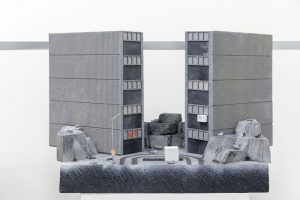
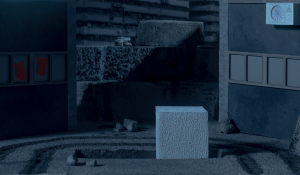
Hilde Fledderman ‘The Trial’, genomineerd door medestudenten voor de Iktinosprijs.
My inspiration is clear. Big Metropolis cities. Soules, but with a lot of souls. Were everybody lives sides by side. There, where only concrete used to make building, as if the city wasn’t sad enough just yet. The city that inspired me to make my project like this was Brussels, especially the north. With this project I try to create awareness. Awareness for architects and designers that cheap and fast doesn’t always have to be ugly and sad. With showing this, I hope that more architects and designers start to design for communities and people instead of just always design the already existing easy way, over and over and over again. For the end of the project, we made a piccturem in this picture I show the disinterests of people into each other throuhg light. I recreated moonlight to already get an eerie feeling, and used light behind the windows of the buildings to show that people are home, but not interacting with each other, nor the outside world.
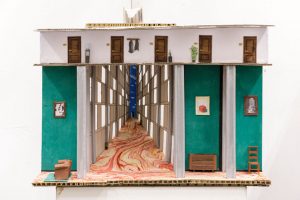
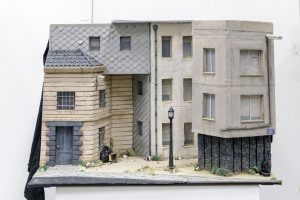
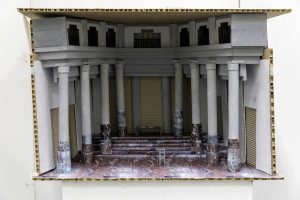
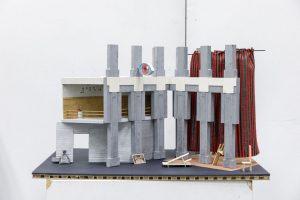
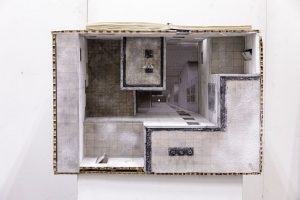

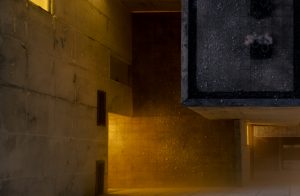
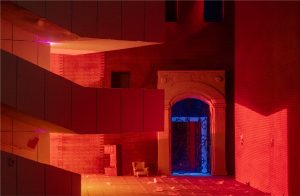
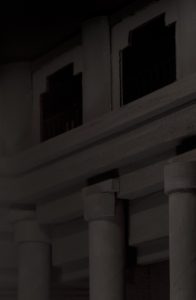
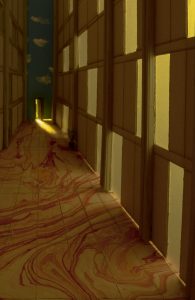
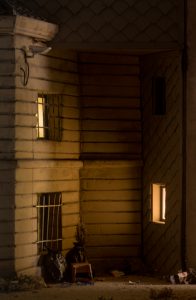
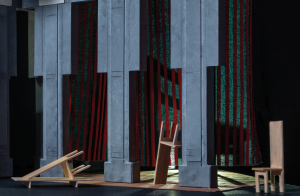
Studio Assignment
The focus of the studio is the design of a set. In the studio we look at sources beyond architecture as a resource for our practice and we work to expand the idea of what architecture can be. We will look at film, set design and scenography and learn from their approaches to narrative, time, space, representation and atmosphere.
Parallel to the design studio the students follow the theory course ‘Spaces of Cinema’ where we watch and analyse films and work to create a theoretical framework for the studio.
Each student starts from a chapter from Kafka’s The Trial. Working on the same book establishes a common ground for dialogue among the students. We mine the text for clues and hints on atmosphere, narrative and setting, clues that will be reimagined in the design of a set. At the end of the studio the different sets representing different chapters will recompose an image of the book in its entirety.
The studio trip takes us to three different areas in Brussels. We focus on specific areas moving from bureaucratic and representational spaces, to industrial heritage and picturesque cityscapes. In each area we collect architectural fragments from interiors and exteriors, public and private spaces, with different histories and atmospheres. We look carefully to establish and expand our collection of ‘found’ architectures. Both material reality and atmosphere are recorded in image and writing during the trip. We build an architectural repertoire made up out of facades, walls, staircases, basements, windows, floors, doors and roofs, to become material at our creative disposal.
Back from the trip we will start interrogating the fragments and try to discover new meanings and possibilities. Everything can be turned into something else. Everyday buildings and interiors of past and present are assembled and re-assembled. What is familiar can become foreign, the public becomes private, the monumental minor. We combine the fragments and transform them, using the methods of bricolage and architectural collage to design the sets. Scenographic design strategies are used to reinterpret our found architectures, considering abstraction and detail, materiality, proportion, perspective, colour, texture and light.
The idea of the stage set will serve as a starting point to address how we can materialize an idea, and how we can use that which is already there; architecture as found as a resource for our design by carefully observing, selecting and transforming. The set designs are then the result of a careful configuration of the different scenes, memories, recollections, reconfigurations, sitting somewhere between the real and the surreal, responding to the source text and its narrative clues. Students will reflect on the typologies they represent: What is a house? What is an office space? How can we represent them? When we rearrange the fragments into a new whole, we pay close attention to the physical and conceptual connection between the parts